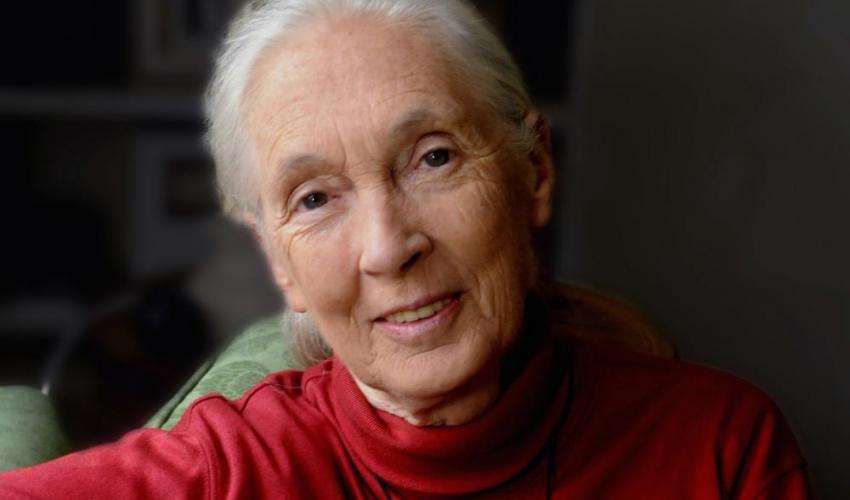Dr Jane Goodall, DBE, Founder, the Jane Goodall Institute, UN Messenger of Peace, and IUCN Patron of Nature talks about collaborative efforts to ensure the survival of chimpanzee populations around the world.
It is well documented that we are facing the world’s sixth great extinction. And there is no doubt that this extinction event is caused by human activity across the globe. For many endangered species, the impacts of climate change such as increases in extreme weather patterns and irregular seasonal changes, conversion of habitat, pollution, disease and trafficking are just a few of the threats that impact their survival.
This is certainly the case for chimpanzees, the species that the Jane Goodall Institute (JGI) is working diligently to protect. Only a century ago there were probably around two million. Today there are a maximum of 250,000 and probably no more than 150,000 – and these are spread out across 21 countries, many in small isolated patches of forest and unlikely to survive. Loss of forest habitat due to logging, agriculture and settlements, disease transmission and the illegal international commercial bushmeat and pet trade are the biggest threats to chimpanzees.
To address these threats, JGI is working closely with local communities, governments, the private sector, academia and other local and international NGOs to jointly develop and implement regional and national conservation action plans using the Open Standards for the Practice of Conservation. These plans are important roadmaps showing how we – local communities, NGOs and governments – work together to jointly manage chimpanzee populations across protected areas, from government managed national parks to community-owned villages and private forest reserves (click here to see an example of a plan guiding joint conservation efforts of great apes in eastern DRC).
We are also using a variety of technologies to scale up what we have learned working in particular areas so that we can make a difference in chimpanzee habitats across Africa. For example, with support from the US National Aeronautics and Space Administration (NASA) and in collaboration with the University of Maryland, the United Nations Environmental Programne (UNEP), the Great Ape Survival Partnership (GRASP), the Great Ape Section of the IUCN Species Survival Commission (SSC) Primate Specialist Group (PSG) and other partners, JGI has been developing a practical Decision Support System that annually monitors and forecasts chimpanzee habitat health in Africa. Since chimpanzees are an important keystone, flagship and umbrella species, an annual chimpanzee habitat health index also supports conservation goals of other species within its large 2.5 million km2 range and could be an important indicator of overall ecosystem health of tropical forests in Africa.
We are also working with Conservation Measures Partnership, IUCN, The Nature Conservancy (TNC), World Wildlife Foundation (WWF), the Wildlife Conservation Society (WCS), Arcus, GRASP, NASA, the US Fish and Wildlife Service (USFWS) and other partners to develop a standard framework for converting remote sensing data into meaningful management information. We need to learn how to harness this data to conserve all species and habitats across the globe.
As part of the Global Forest Watch network, JGI – in collaboration with the World Resources Institute (WRI) and Google Earth Outreach – developed a revolutionary mobile app that enables village forest monitors and protected area rangers to access and use satellite data on forest loss to more effectively identify and report illegal activities on the ground, turning remote sensing data into conservation action.
Thanks to a partnership with Esri, some of these technologies and tools will be available to be used by Roots & Shoots groups all over the world, contributing to a Tapestry of Hope. In 1991, on my veranda in Dar es Salaam, I met a group of 12 Tanzanian high school students to discuss problems that concerned them such as poaching, street children and pollution, and what they could do to address them. It was with these young people that Roots & Shoots was born. Today, the Roots & Shoots network spans 130 countries with youth of all ages. This map represents more than 1,700 of their local service projects that, when woven together, creates a tapestry of real change.
We are looking forward to sharing some of this work at the IUCN World Conservation Congress, and learning about the work of other conservationists so that we can all leverage best practices around the globe to ensure a hopeful future for chimpanzees and all endangered species.
Not only are young people rolling up their sleeves and making a difference, there are hundreds of stories of inspirational people and groups who are restoring habitats and bringing species back from the brink.
- Dr Jane Goodall, DBE, Founder, the Jane Goodall Institute and UN Messenger of Peace
RELEVANT SOCIAL MEDIA INFORMATION
Website www.janegoodall.org
Blog news.janegoodall.org
Facebook @JaneGoodall, @JaneGoodallInst, @RootsAndShoots
Twitter/Instagram @JaneGoodallInst @RootsAndShoots











